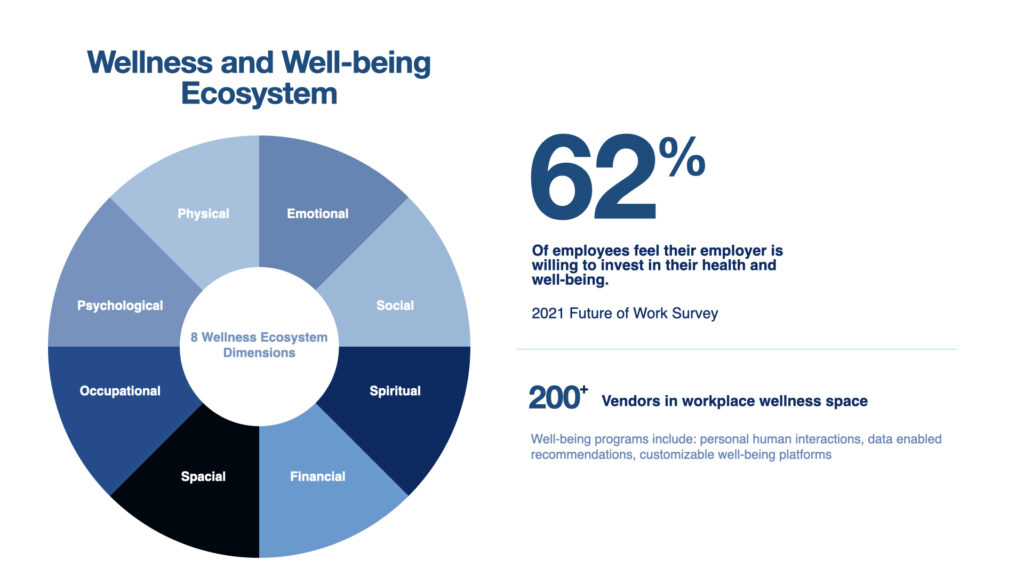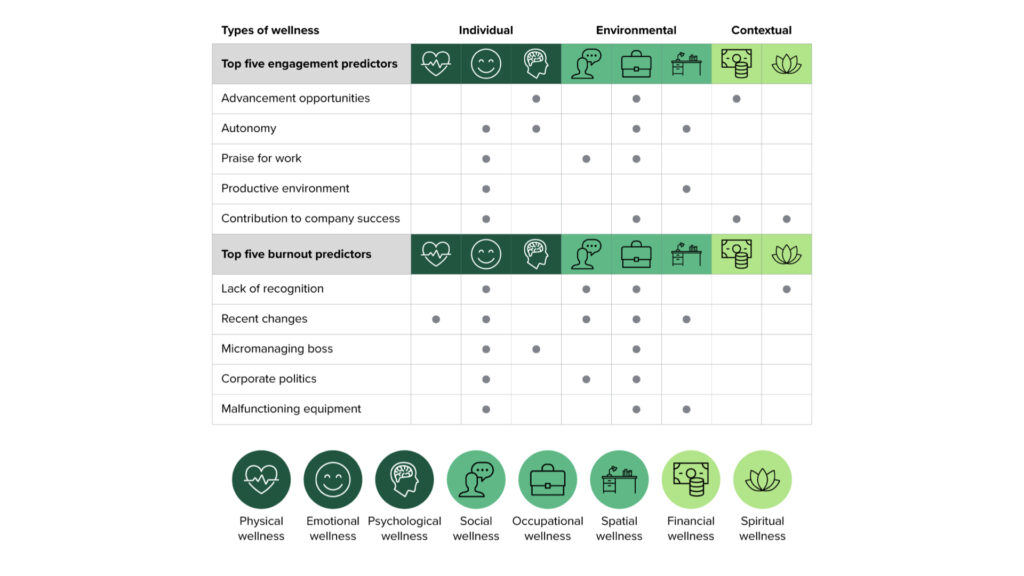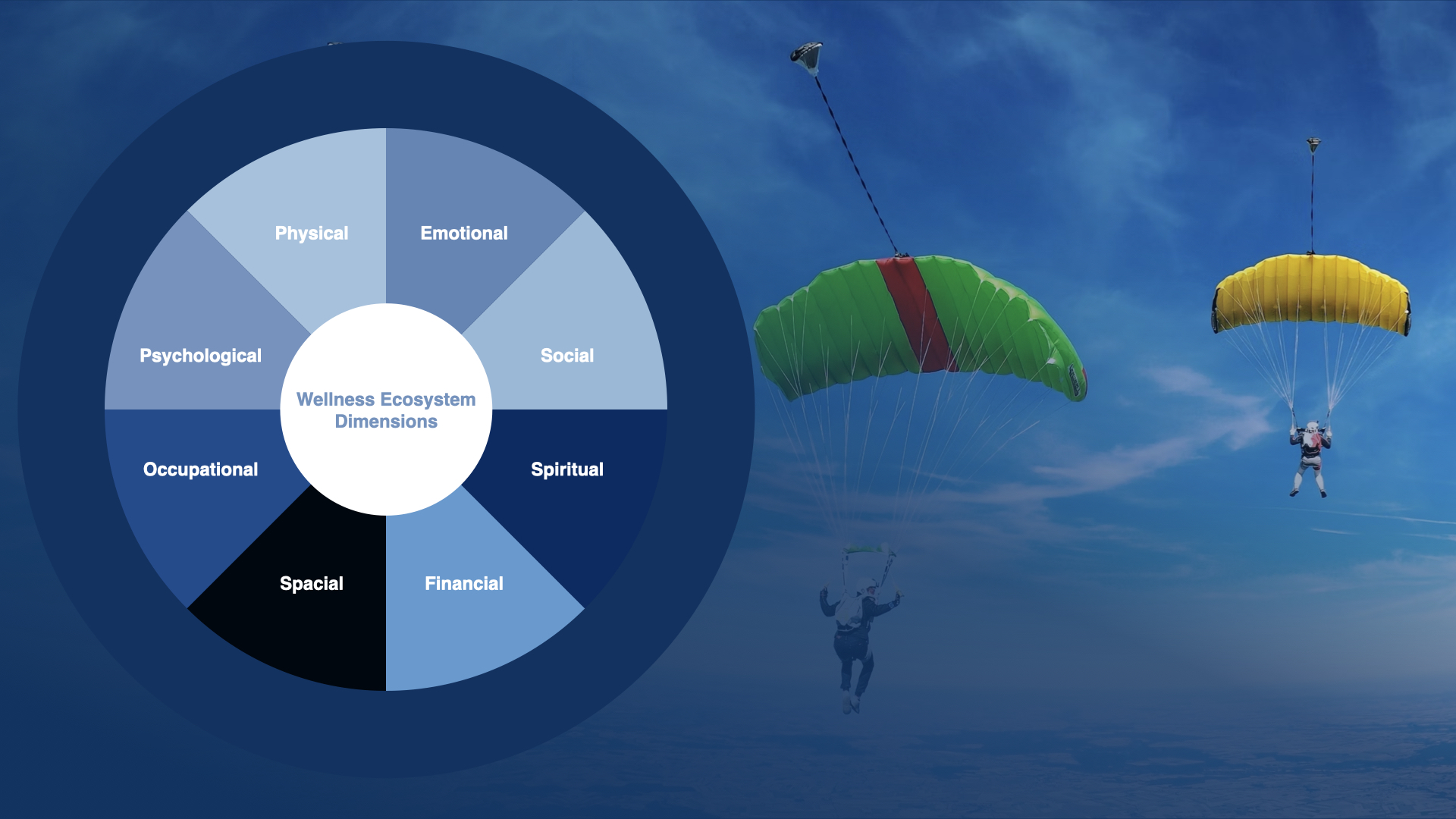According to a Forrester Future of Work Survey, 62% of Employees believe their employer is willing to invest in their health and well-being. Ok, that’s great, more than half of employees feel like their employer has an interest in supporting them. When you look at it from a typical team size of 7-20 that picture changes a bit. It also means that 38% do not believe their employer has a vested interest in their well-being. Or to put it another way, 4 out of 10 people are not sure if their employer is willing to invest in them in a way that recognizes the 8 dimensions of the corporate employee wellness ecosystem. Employee wellbeing and work-life balance are essential for every single person, and I hope we can all agree that at the end of the day your team is most valuable asset. So why the delta? Is it real, or perceived?

Wellness and Well-being Ecosystem, Future of Work Survey Takeaway
The eight dimensions of the wellness and well-being ecosystem
- Emotional
- Social
- Spiritual
- Financial
- Spacial
- Occupational
- Psychological
- Physical
So Why the Delta? Is it real, or perceived?
If we look closely at the keyword ‘invest’ here, what do we think that actually means? From the standpoint of the organization ‘invest’ translates to capital expense. Capital expense means an impact to margin, and an impact to profitability. From the standpoint of the employee it’s safe to assume that it has a more holistic meaning, where there is an emotional or empathetic investment along with the cost of providing programs and resources to people.
I take issue with some of the language used that gets in our way of recognizing ‘people’. Take human capital for example, or talent acquisition, or human resource. These words have a way of distancing ourselves from relating to people and start to see each other as assets to be leveraged in a transaction.
Broadly speaking there are well over 200+ vendors in the workplace wellness space. They offer services like meditation, yoga, habit creation, leadership coaching, nutrition and everything in between. In addition they are each trying to solve for the issue of vendor fatigue. Even well-intentioned organizations can wind up implementing a ‘check-box’ solution, that inevitably creates more friction.
Even well-intentioned organizations wind up implementing check-box solutions
Consider the situation for a moment, where you are an employee and your employer has made a ‘wellness’ program available to you. You hear about it during a meeting, or a hallway conversation, or see it in a presentation. You want to look into it to take advantage, however the information is in a portal. Some HR portal, linked off of another portal and if you’re lucky some information comes back in your search results. You’re excited to sign up, but it doesn’t work with your credentials, you need to create an account, or have an access PIN, or promo code and after 30 minutes or 3 days in back and forth exchanges to figure out how your employer is enrolled, you give up. This friction barrier is a by-product of poorly designed experiences at the least, or a lack of ‘investment’ in providing a useable and useful solution?

Image Credit, Forrester Employee Benefits Beyond Wellness Report
Unfortunately where this is felt the most is with frontline workers. Employee experience strategies tend to fall short with the employees who need it most. This tends to have a direct impact on Customer Experience (CX).
According to another recent study by Forrester, the average CX quality score had declined in 2022 to pre-pandemic levels in 2022 for a score of 71.2%. As leaders increase pressure on frontline workers, the result is attrition, burnout and stress.
While no organization wants to lose customers or feel the impact to their bottom line as CX scores drop, where to focus for improvement is up for debate. It seems that an equal amount of focus should also be put on EX (Employee Experience) with a holistic lens.
Companies Want Solutions
So, what are companies looking for to help address the issue?
- A Culture of Wellness and Attainable Wellness – education and resources that provide tools for employees to assess where they are with respect to the 8 dimensions above, and provide tools to help them on their journey – while facilitating a culture that recognizes and supports overall well-being with empathy.
- Accessible, Inclusive, Adaptive and Innovative – checking off on all of the nuanced needs of any solution is hard, and when it comes to employee well-being it’s no different, solutions should be proactive and also reparative, they should be customizable and they should be accessible to everyone with the same level of services.
- Measurable and User Centered – it’s important to be able to integrate a continuous feedback cycle between the people who use the provided solutions and the people who provide and deliver them. Equal measures of both qualitative (how is it doing, are people satisfied) and quantitative (what is it doing, how much or how often are service requests made) help create actionable data points for continuous improvement.


